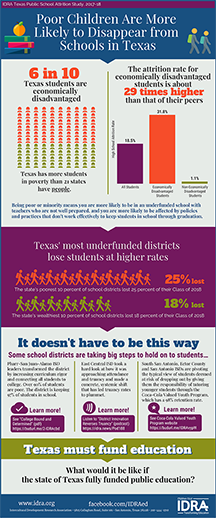 In an additional analysis to IDRA’s annual attrition study released in December 2018, IDRA examined data from a national and statewide perspective on attrition rates of economically disadvantaged students and examined the issue in terms of school district property wealth.
In an additional analysis to IDRA’s annual attrition study released in December 2018, IDRA examined data from a national and statewide perspective on attrition rates of economically disadvantaged students and examined the issue in terms of school district property wealth.
Key findings show:
- For the class of 2017, the attrition rate reported by the Texas Education Agency for economically disadvantaged students was about 29 times higher than that of their peers. The attrition rate for economically disadvantaged students was 31.8 percent while the rate for non-economically disadvantaged students was 1.1 percent.
- About six out of 10 students in Texas public schools are identified as economically disadvantaged. Texas has more students in poverty than 21 states have people of all ages and incomes.
- Attrition rates are higher in property poor districts and large urban areas. The state’s poorest 10 percent of school districts in terms of property wealth had an attrition rate of 25.1 percent compared do a 17.7 percent attrition rate in the highest wealth group.
- Texas ranked second nationally in on-time graduation rates of economically disadvantaged students with a rate of 86.0 percent compared to the national average of 77.6 percent in 2015-16. But Texas ranked 10th in graduating another large subgroup of students: English learners with a rate of 73.7 percent.
- The school district groups with high attrition rates include large urban school districts (e.g., Austin, Dallas, Houston), suggesting that average property wealth districts could benefit from increased funding that would be generated by increasing compensatory and English learner funding weights.
It doesn’t have to be this way.
This infographic highlights key findings from the study and points to steps we can take to graduate more students. See the report press release (January 31, 2019).
Download full-size infographic on the attrition study in Texas.
Download printable infographic (letter-size pdf).


